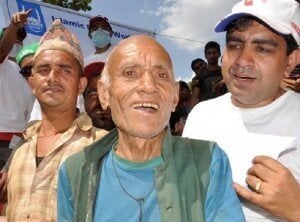Helping people out of poverty is full of challenges, so it is not surprising that responding to disasters is even more problematic. Being able to find ways to overcome these problems is what makes the difference between an emergency and a catastrophe.
After every natural disaster, the humanitarian sector is challenged to come up with the best way to save lives and minimise suffering. Every time a disaster occurs, we find new problems and have to find innovative solutions. The earthquake in Nepal is one such challenge.
From our first day in Nepal, Islamic Relief's disaster response team realised that the people who needed help the most were not in the capital, although it had seen its share of devastation. Kathmandu might be easy to reach and offer good opportunities for the media, but we found that the greatest need was in rural areas which had been cut off from the rest of the world. Roads had completely disappeared and villages had been flattened.

We tapped into the knowledge, skills and experience of responding to emergencies across the world over many years to assemble a team of first responders from Pakistan, Bangladesh, India and the Philippines, with support from our UK and US offices. Our assessment team searched for villages and communities that had not yet been reached, and in the district of Sindhupal Chowk, we found two villages, Sipapokhari and Bhimtar, where 2,500 people had lost their homes, their livestock, and their possessions.
We identified the numbers in need and prepared a balanced food pack weighing more than 16kg and containing essential items to last a family for seven to ten days. Reaching two villages on the top of the mountain with eight tonnes of aid in a truck and without any sort of road was a serious task, but, with thanks to God, we managed it. It took us four hours, but it was worth it, as the distribution went well.

Despite everything they had lost, children started to jump up and down with excitement, and smiles spread across the faces of adults who were exhausted and traumatised after a week without help. They told us we were the first organisation to reach them after the earthquake.
We were amazed when a young mother approached us and, in English, said: "Thank you for helping us, thank you for saving my young children." Before we left the village, a group of young children, with big smiles on their faces, started chanting "thank you, thank you, thank you". We left promising that we would be back with temporary shelters. In those villages, not a single house escaped damage.
And so, we continue our work. Our next task is to prepare another aid convoy to reach more villages.
Please help Islamic Relief and other member agencies of the Disasters Emergency Committee reach more people by supporting the DEC's Nepal Emergency Appeal at www.dec.org.uk. More of my blogs from Nepal can be found at www.islamic-relief.org.uk.
